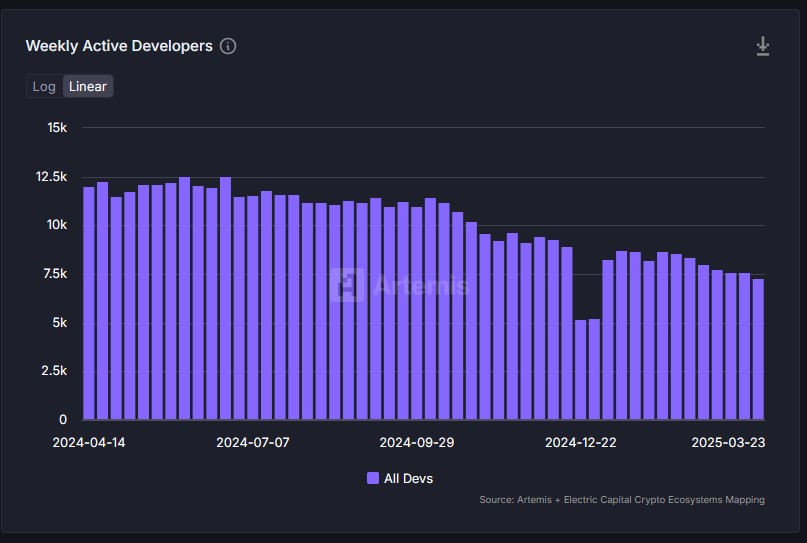The cryptocurrency landscape is experiencing a significant shift, highlighted by a sharp decline in active developers. Recent data from the crypto analytics platform Artemis Terminal reveals that the number of weekly active developers plunged nearly 40% in just one year, dropping from approximately 12,380 on March 17, 2024, to around 7,600 by March 16, 2025. This decline signals a potential weakening of the Web3 ecosystem, as the number of developers is often viewed as a key indicator of innovation and the ongoing health of blockchain protocols across diverse ecosystems.
“There’s been a lot of narrative-led development, but there should be more development-led narratives,” remarked Optimism contributor Binji Pande on social media, illustrating the urgent need for a shift back to more foundational work in crypto.
The reduction in developer activity has sparked conversations within the community, emphasizing a growing concern that the crypto space may be veering off course. Many attribute this trend to a focus on speculative narratives rather than sustainable, utility-driven projects. Developer Ben Ward pointed out that the current hype surrounding memecoins, such as those launched with protocols like Pump.fun, illustrates the short-term gains overshadowing meaningful product development. This has led to claims that while the memecoin phenomenon may be incredibly profitable, it does not build a solid foundation for the industry’s future.
According to Pande, “If nothing meaningful happens onchain, distribution loses its power,” a statement underscoring the precarious nature of current trends in the cryptocurrency world.
The call for action resonates with many in the field, as developers and advocates stress the importance of returning to core principles—creating robust tools and applications that enhance user experience and utility. As the industry stands at a crossroads, the push for developer-led innovation promises to shape the future direction of cryptocurrency, potentially steering it back toward a more sustainable and impactful trajectory.
Impact of Developer Activity Drop in the Crypto Space
The significant drop in the number of weekly active developers in the crypto industry has implications for innovation and long-term sustainability in Web3. Here are the key points to understand:
- Sharp Decline in Active Developers:
- Active developers dropped from 12,380 to around 7,600 within a year, marking a 38.6% decline.
- This decline indicates a potential slowdown in innovation within the Web3 ecosystem.
- Indicator of Ecosystem Health:
- The number of active developers is a critical indicator of the overall health of the Web3 ecosystem.
- Higher developer activity fosters greater innovation and supports long-term sustainability of blockchain protocols.
- Shift to Narrative-Led Developments:
- Developer-led innovations have taken a backseat to speculative, narrative-driven projects.
- This shift may lead to unsustainable practices in the industry, as exemplified by the recent rise of memecoins.
- Calls for Support and Focus on Utility:
- Experts in the field are calling for more support for developers, emphasizing the need for meaningful on-chain developments.
- A greater focus on end-to-end product development, rather than just code creation, is essential for revitalizing the sector.
- Memecoins as a Dominant Narrative:
- Memecoins have emerged as the most profitable phenomena in Web3, drawing attention away from valuable projects.
- This trend raises concerns about whether the crypto industry is prioritizing entertainment over utility and sustainability.
- Need for a Return to Basics:
- There is a consensus among developers that the industry should return to foundational principles to enhance the future potential of crypto.
- Reimagining the value proposition of crypto to be more futuristic could help in recapturing interest and utility.
“If nothing meaningful happens on-chain, distribution loses its power.” – Binji Pande
Understanding these dynamics is crucial for readers interested in the future of cryptocurrency, as they highlight the necessity for genuine innovation over speculative trends. Engaging with supportive developer narratives may help ensure the long-term vitality of the Web3 ecosystem.
Crypto Developer Activity Plummets: A Shift from Innovation to Memecoins
The cryptocurrency landscape is witnessing troubling trends, most notably highlighted by a significant decline in weekly active developers, which has dropped by nearly 40% over the past year. According to a recent report from Artemis Terminal, the industry’s overall health appears to be waning as fewer developers engage with vital projects, resulting in a staggering drop from 12,380 active developers to about 7,600 within the span of a year. This raises concerns about the sustainability and innovative momentum of the Web3 ecosystem.
In contrast to the decline in developer involvement, an intriguing shift toward “narrative-led” developments has captured the attention of both the market and venture capitalists. This trend emphasizes the allure of memecoins and speculative trading rather than the core technological advancements that typically drive the space. While some projects thrive amidst this frenzy, such as the DeFi “memecoin casino” model, this short-term success raises questions about long-term viability. The challenge lies in balancing immediate profit-making with sustainable innovation—something that many developers, like Optimism contributor Binji Pande, highlight as a pressing concern.
For developers deeply invested in building and enhancing blockchain technology, this narrative shift represents both an opportunity and a threat. Those at the forefront of meaningful projects may struggle to attract attention or funding, as quick-win solutions overshadow foundational work. Conversely, this environment can also spur a pushback, prompting developers to advocate for more developer-centric narratives that prioritize substantial product utility over speculative hype.
Moreover, this environment poses challenges for investors and stakeholders. As the space becomes dominated by flashy projects that may not stand the test of time, those looking for sound investments could find themselves navigating a minefield of fleeting trends. The real risk is that without substantial on-chain activity and innovative products, the industry’s perceived value might diminish, affecting everyone from developers to end-users.
In essence, the call for a return to fundamental development not only resonates within the developer community but also serves as a cautionary tale for the entire crypto ecosystem. Maintaining a focus on sustainable innovation amidst the allure of quick rewards will likely determine the future trajectory of blockchain technology and its diverse applications.

















